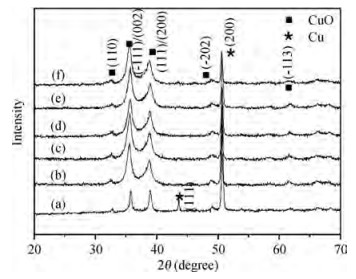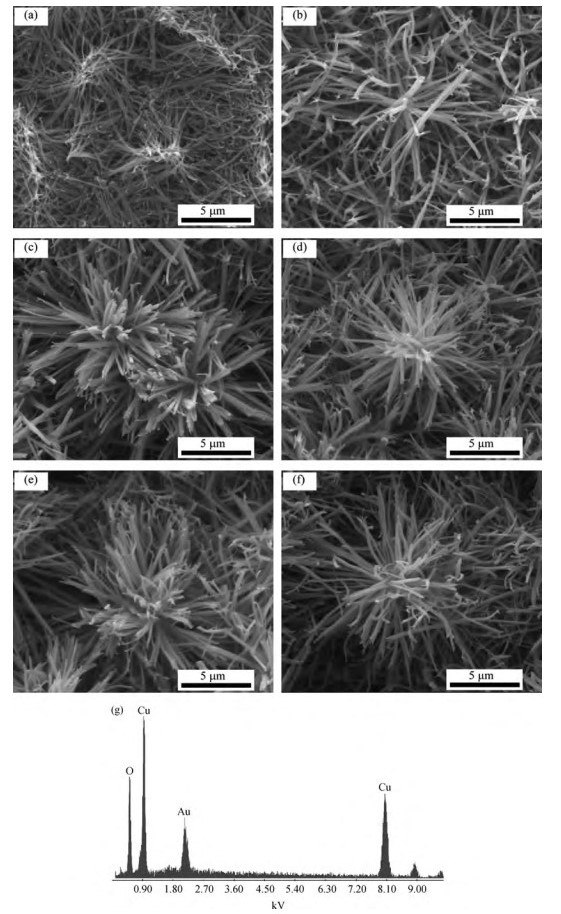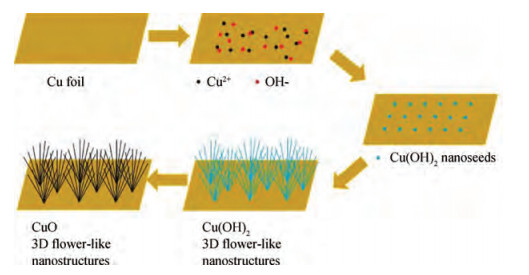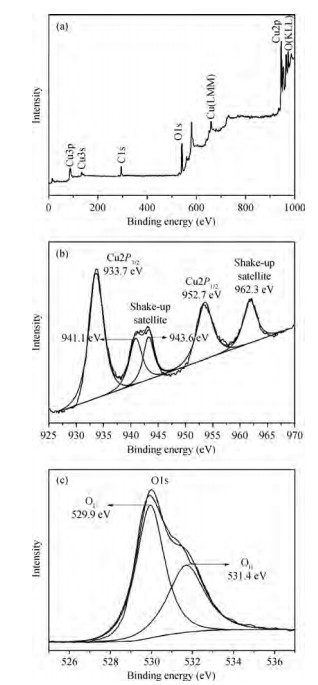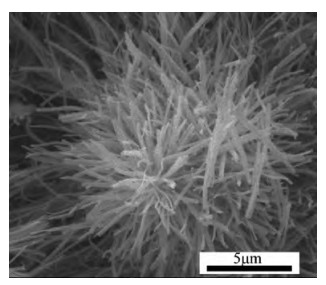| Citation: |
Qingfei Fan, Qi Lan, Meili Zhang, Ximei Fan, Zuowan Zhou, Chaoliang Zhang. Preparation and photocatalytic activities of 3D flower-like CuO nanostructures[J]. Journal of Semiconductors, 2016, 37(8): 083002. doi: 10.1088/1674-4926/37/8/083002
****
Q F Fan, Q Lan, M L Zhang, X M Fan, Z W Zhou, C L Zhang. Preparation and photocatalytic activities of 3D flower-like CuO nanostructures[J]. J. Semicond., 2016, 37(8): 083002. doi: 10.1088/1674-4926/37/8/083002.
|
Preparation and photocatalytic activities of 3D flower-like CuO nanostructures
DOI: 10.1088/1674-4926/37/8/083002
More Information
-
Abstract
Hierarchical 3D flower-like CuO nanostructures on the Cu substrates were synthesized by a wet chemical method and subsequent heat treatment. The synthesis, structure and morphologies of obtained samples under different concentrations of Na2S2O3 were investigated in detail and the possible growth mechanisms of the 3D flower-like CuO nanostructures were discussed. Na2S2O3 plays a key role in the generation of the 3D flower-like CuO nanostructures. When the concentration of Na2S2O3 is more than 0.4 mol/L, the 3D flower-like CuO nanostructures can be prepared on the Cu foils. The photocatalytic performances were studied by analyzing the degradation of methyl orange (MO) in aqueous solution in the presence of hydroxide water (H2O2). The 3D flower-like CuO nanostructures exhibit higher photocatalytic activity (96.2% degradation rate) than commercial CuO particles (36.3% degradation rate). The origin of the higher photocatalytic activity of the 3D flower-like CuO nanostructures was also discussed. -
References
[1] Hu X, Yu J C. Continuous aspect-ratio tuning and fine shape control of monodisperseα-Fe2O3 nanocrystals by a programmed microwave-hydrothermal method. Adv Funct Mater, 2008, 18(6): 880 doi: 10.1002/(ISSN)1616-3028[2] Shpaisman N, Givan U, Patolsky F. Electrochemical synthesis of morphology controlled segmented CdSe nanowires. ACS Nano, 2010, 4(4): 1901 doi: 10.1021/nn901661z[3] Faisal M, Khan S B, Rahman M M, et al. Ethanol chemi-sensor: evaluation of structural, optical and sensing properties of CuO nanosheets. Mater Lett, 2011, 65(9): 1400 doi: 10.1016/j.matlet.2011.02.013[4] Liu Y, Liao L, Li J, et al. From copper nanocrystalline to CuO nanoneedle array: synthesis, growth mechanism, and properties. J Phys Chem C, 2007, 111(13): 5050 doi: 10.1021/jp069043d[5] Wang W, Zhan Y, Wang G. One-step, solid-state reaction to the synthesis of copper oxide nanorods in the presence of a suitable surfactant. Chem Commum, 2001, (8): 727 doi: 10.1039/b008215p[6] Cao M, Hu C, Wang Y, et al. A controllable synthetic route to Cu, Cu2O, and CuO nanotubes and nanorods. Chem Commum, 2003, (15): 1884 doi: 10.1039/b304505f[7] Hübner M, Simion C E, Tomescu-Stănoiu A, et al. Influence of humidity on CO sensing with p-type CuO thick film gas sensors. Sens Actuators B, 2011, 153(2): 347 doi: 10.1016/j.snb.2010.10.046[8] Zhou L P, Wang B X, Peng X F, et al. On the specific heat capacity of CuO nanofluid. Adv Mech Eng, 2010, 2: 172085 http://cn.bing.com/academic/profile?id=2099389381&encoded=0&v=paper_preview&mkt=zh-cn[9] Wang S B, Hsiao C H, Chang S J, et al. A CuO nanowire infrared photodetector. Sens Actuators A, 2011, 171(2): 207 doi: 10.1016/j.sna.2011.09.011[10] Zhu Y W, Yu T, Cheong F C, et al. Large-scale synthesis and field emission properties of vertically oriented CuO nanowire films. Nanotechnology, 2005, 16(1): 88 doi: 10.1088/0957-4484/16/1/018[11] Hu Liqin, Zhang Dian, Hu Hailong, et al. Field electron emission from structure-controlled one-dimensional CuO arrays synthesized by wet chemical process. Journal of Semiconductors, 2014, 35(7): 073003 doi: 10.1088/1674-4926/35/7/073003[12] Anandan S, Wen X, Yang S. Room temperature growth of CuO nanorod arrays on copper and their application as a cathode in dye-sensitized solar cells. Mater Chem Phys, 2005, 93(1): 35 doi: 10.1016/j.matchemphys.2005.02.002[13] Zhang X, Shi W, Zhu J, et al. High-power and high-energy-density flexible pseudocapacitor electrodes made from porous CuO nanobelts and single-walled carbon nanotubes. ACS Nano, 2011, 5(3): 2013 doi: 10.1021/nn1030719[14] Sun S, Chen A, Sun Y, et al. Nanoporous copper oxide ribbons assembly of free-standing nanoneedles as biosensors for glucose. Analyst, 2015, 140: 5205 doi: 10.1039/C5AN00609K[15] Liu J, Jin J, Deng Z, et al. Tailoring CuO nanostructures for enhanced photocatalytic property. J Colloid Interface Sci, 2012, 384(1): 1 doi: 10.1016/j.jcis.2012.06.044[16] Zhang D W, Chen C H, Zhang J, et al. Novel electrochemical milling method to fabricate copper nanoparticles and nanofibers. Chem Mater, 2005, 17(21): 5242 doi: 10.1021/cm051584c[17] Ziolo J, Borsa F, Corti M, et al. Cu nuclear quadrupole resonance and magnetic phase transition in CuO. J Appl Phys, 1990, 67(9): 5864 doi: 10.1063/1.345996[18] Zhou K, Wang R, Xu B, et al. Synthesis, characterization and catalytic properties of CuO nanocrystals with various shapes. Nanotechnology, 2006, 17(15): 3939 doi: 10.1088/0957-4484/17/15/055[19] Jia W, Liu Y, Hu P, et al. Ultrathin CuO nanorods: controllable synthesis and superior catalytic properties in styrene epoxidation. Chem Commun, 2015, 51(42): 8817 doi: 10.1039/C5CC02480C[20] Zhong Z, Ng V, Luo J, et al. Manipulating the self-assembling process to obtain control over the morphologies of copper oxide in hydrothermal synthesis and creating pores in the oxide architecture. Langmuir, 2007, 23(11): 5971 doi: 10.1021/la063344x[21] Liu J, Huang X, Li Y, et al. Self-assembled CuO monocrystalline nanoarchitectures with controlled dimensionality and morphology. Cryst Growth Des, 2006, 6(7): 1690 doi: 10.1021/cg060198k[22] Yu Y, Zhang J. Solution-phase synthesis of rose-like CuO. Mater Lett, 2009, 63(21): 1840 doi: 10.1016/j.matlet.2009.05.061[23] Zhang X, Wang G, Liu X, et al. Different CuO nanostructures: synthesis, characterization, and applications for glucose sensors. J Phys Chem C, 2008, 112(43): 16845 doi: 10.1021/jp806985k[24] Wang G, Gu A, Wang W, et al. Copper oxide nanoarray based on the substrate of Cu applied for the chemical sensor of hydrazine detection. Electrochem Commun, 2009, 11(3): 631 doi: 10.1016/j.elecom.2008.12.061[25] Umar A, Rahman M M, Al-Hajry A, et al. Enzymatic glucose biosensor based on flower-shaped copper oxide nanostructures composed of thin nanosheets. Electrochem Commun, 2009, 11(2): 278 doi: 10.1016/j.elecom.2008.11.027[26] Wang W, Zhang L, Tong S, et al. Three-dimensional network films of electrospun copper oxide nanofibers for glucose determination. Biosens Bioelectron, 2009, 25(4): 708 doi: 10.1016/j.bios.2009.08.013[27] Pan Q, Jin H, Wang H, et al. Flower-like CuO film-electrode for lithium ion batteries and the effect of surface morphology on electrochemical performance. Electrochimica Acta, 2007, 53(2): 951 doi: 10.1016/j.electacta.2007.08.004[28] Yu L, Zhang G, Wu Y, et al. Cupric oxide nanoflowers synthesized with a simple solution route and their field emission. J Cryst Growth, 2008, 310(12): 3125 doi: 10.1016/j.jcrysgro.2008.03.026[29] Koshy J, Soosen S M, Chandran A, et al. Correlated barrier hopping of CuO nanoparticles. Journal of Semiconductors, 2015, 36(12): 122003 doi: 10.1088/1674-4926/36/12/122003[30] Sun S, Zhang X, Zhang J, et al. Surfactant-free CuO mesocrystals with controllable dimensions: green ordered-aggregation-driven synthesis, formation mechanism and their photochemical performances. Cryst Eng Comm, 2013, 15(5): 867 doi: 10.1039/C2CE26216A[31] Liu Y, Chu Y, Zhuo Y, et al. Anion-controlled construction of CuO honeycombs and flowerlike assemblies on copper foils. Cryst Growth Des, 2007, 7(3): 467 doi: 10.1021/cg060480r[32] Zou G, Li H, Zhang D, et al. Well-aligned arrays of CuO nanoplatelets. J Phys Chem B, 2006, 110(4): 1632 doi: 10.1021/jp0557363[33] Chu D Q, Mao B G, Wang L M. Microemulsion-based synthesis of hierarchical 3D flowerlike CuO nanostructures. Mater Lett, 2013, 105: 151 doi: 10.1016/j.matlet.2013.04.067[34] Jana S, Das S, Das N S, et al. CuO nanostructures on copper foil by a simple wet chemical route at room temperature. Mater Res Bull, 2010, 45(6): 693 doi: 10.1016/j.materresbull.2010.02.014[35] Wang W, Lan C, Li Y, et al. A simple wet chemical route for large-scale synthesis of Cu(OH)2 nanowires. Chem Phys Lett, 2002, 366(3): 220 http://www.researchgate.net/publication/244134275_A_simple_wet_chemical_route_for_large-scale_synthesis_of_Cu(OH)_2_nanowires[36] Wang Z L, Kong X Y, Wen X, et al. In situ structure evolution from Cu(OH)2 nanobelts to copper nanowires. J Phys Chem B, 2003, 107(33): 8275 doi: 10.1021/jp035557q[37] Sun F, Qiao X, Tan F, et al. Fabrication and photocatalytic activities of ZnO arrays with different nanostructures. Appl Surf Sci, 2012, 263: 704 doi: 10.1016/j.apsusc.2012.09.144[38] Ethiraj A S, Kang D J. Synthesis and characterization of CuO nanowires by a simple wet chemical method. Nanoscale Res Lett, 2012, 7(1): 1 doi: 10.1186/1556-276X-7-1[39] Zhang H, Yang D, Ma X, et al. Synthesis of flower-like ZnO nanostructures by an organic-free hydrothermal process. Nanotechnology, 2004, 15(5): 622 doi: 10.1088/0957-4484/15/5/037[40] Liu H, Wu X, Li X, et al. Simple preparation of scale-like CuO nanoparticles coated on tetrapod-like ZnO whisker photocatalysts. Chin J Catal, 2014, 35(12): 1997 doi: 10.1016/S1872-2067(14)60198-4[41] Li B, Wang Y. Facile synthesis and photocatalytic activity of ZnO-CuO nanocomposite. Superlattice Microstruct, 2010, 47(5): 615 doi: 10.1016/j.spmi.2010.02.005[42] Ai Z, Zhang L, Lee S, et al. Interfacial hydrothermal synthesis of Cu@ Cu2O core-shell microspheres with enhanced visible-light-driven photocatalytic activity. J Phys Chem C, 2009, 113(49): 20896 doi: 10.1021/jp9083647[43] Borgohain K, Murase N, Mahamuni S. Synthesis and properties of Cu2O quantum particles. J Appl Phys, 2002, 92(3): 1292 doi: 10.1063/1.1491020[44] Jin Y, Cui Q, Wang K, et al. Investigation of photoluminescence in undoped and Ag-doped ZnO flowerlike nanocrystals. J Appl Phys, 2011, 109(5): 053521 doi: 10.1063/1.3549826[45] Wang H, Xu J Z, Zhu J J, et al. Preparation of CuO nanoparticles by microwave irradiation. J Cryst Growth, 2002, 244(1): 88 doi: 10.1016/S0022-0248(02)01571-3[46] Wang Y, Jiang T, Meng D, et al. Synthesis and enhanced photocatalytic property of feather-like Cd-doped CuO nanostructures by hydrothermal method. Appl Surf Sci, 2015, 355: 191 doi: 10.1016/j.apsusc.2015.07.122[47] Chen W, Hong L, Liu A L, et al. Enhanced chemiluminescence of the luminol-hydrogen peroxide system by colloidal cupric oxide nanoparticles as peroxidase mimic. Talanta, 2012, 99: 643 doi: 10.1016/j.talanta.2012.06.061[48] Li H, Liao J, Zeng T. A facile synthesis of CuO nanowires and nanorods, and their catalytic activity in the oxidative degradation of Rhodamine B with hydrogen peroxide. Catal Commun, 2014, 46: 169 doi: 10.1016/j.catcom.2013.12.008[49] Liao J, Li H, Zhang X, et al. Facile fabrication of Ti supported CuO film composed of bamboo-leaf-like nanosheets and their high catalytic performance in the oxidative degradation of methylene blue with hydrogen peroxide. Appl Catal A, 2015, 491: 94 doi: 10.1016/j.apcata.2014.11.042[50] Elechiguerra J L, Reyes-Gasga J, Yacaman M J. The role of twinning in shape evolution of anisotropic noble metal nanostructures. J Mater Chem, 2006, 16(40): 3906 doi: 10.1039/b607128g[51] Shi J, Li J, Huang X, et al. Synthesis and enhanced photocatalytic activity of regularly shaped Cu2O nanowire polyhedra. Nano Research, 2011, 4(5): 448 doi: 10.1007/s12274-011-0101-5 -
Proportional views





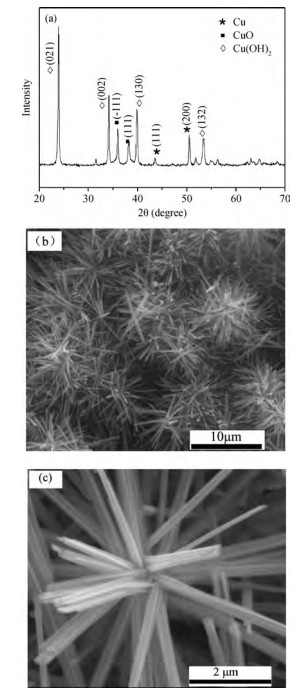
 DownLoad:
DownLoad:
